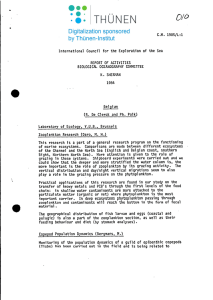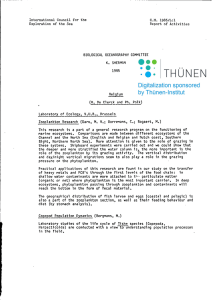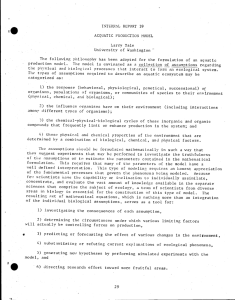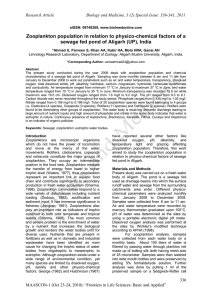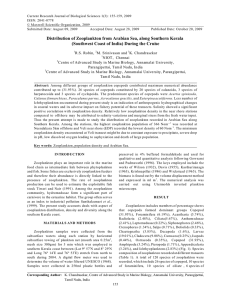DID
advertisement
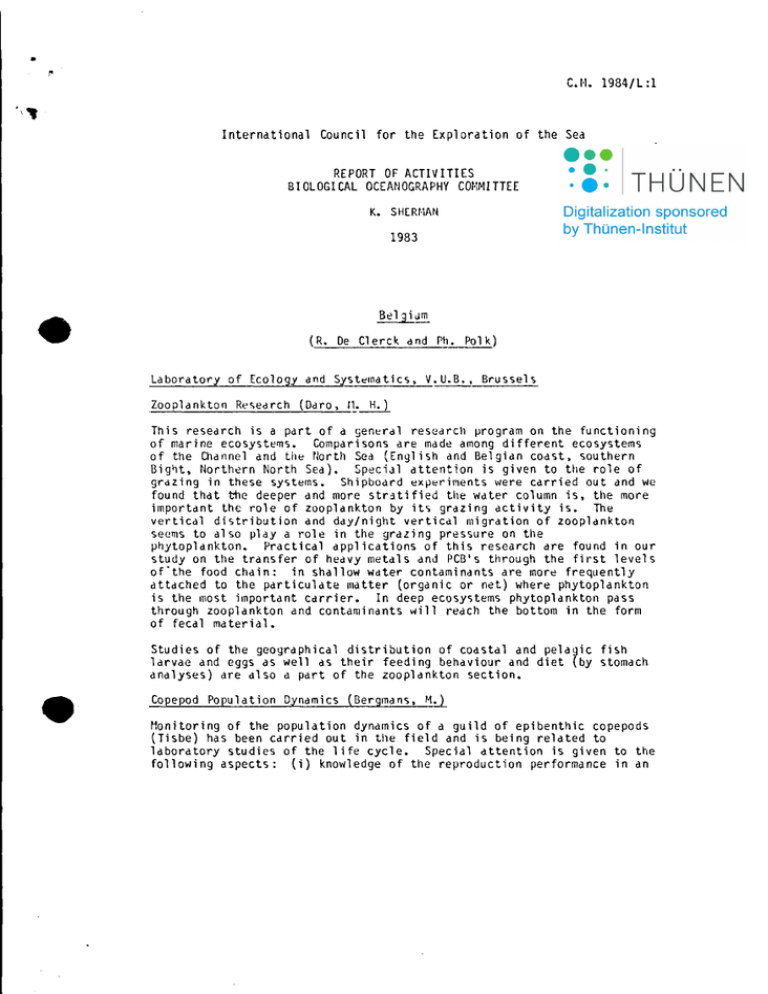
G.l-I. 1984{l:1
International Council for the Exploration of the Sea
REPORT OF ACTIVITIES
BIOlOGICAl OCEANOGRAPHY COMMITTEE
DID
K. SHERHAN
1983
Belgium
(R. Oe Clerck and rh. Polk)
Laboratory of Ecology and
Syst~matics,
Zooplankton Research (Daro,
V.U.B" Brussels
r!.-~
This research is apart of a general research pr09ram on the functioning
of marine ecosystems. Comparisons are made among different ecosystems
of tlle Channel and the florth Sca (Engl ish and Belgian coast, southern
Big~t. Northern North Seal.
Special attention is given to the role of
grazing in these systems. Shipboard experiments were carried out and we
found that t'hc deeper and more stratified the water column is, the more
important thc role of zooplankton by it> grazing activity iso The
vertical distribution and day/night vertical migration of zooplankton
seems to also playa role in the grazing pressure on the
phytoplankton. Practical applications of this research are found in our
study on the transfer of heavy metals and PCB's through the first levels
of'the food chain: in shallow water contaminants are more frequently
attaehed to the partieulate matter (organic or net) where phytoplankton
is the most important carrier. In deep ecosystems phytoplankton pass
through zooplankton and contaminants will reach the bottom in the form
of feeal material.
Studies of the geographieal distribution of eoastal and pelagie fish
larvac and eggs as well as their feeding behaviour and diet (by stomaeh
analyses) are also apart of the zooplankton seetion.
Copepod Population Dynamics (Bergmans, M.)
Honitoring of the population dynamies of a guild of epibenthic copepods
(Tisbe) has been earried out in the field and is being related to
laboratory studies of the life eyele. Special attention is given to the
following aspects: (i) knowledge of the reproduetion performance in an
-2-
"ecological vacuum" (yleldlng null hypotheses on growth rates and age
distribution in the field by excluding competltlon and predation
effects); (li) the possibility of adaptive fine-tuning of the life cycle
(Includlng effects on "r" and the "net reproductlve rate") as a function
of demographie eonditions. i.e. in expanding. stable and declinlng
populdtions.
Non-living Partlcular IKganic r'\ltter (Pissierssens. P.)
Llttle Is known about the role of Non-Living Particular Organic t\ltter
(also called detritus) in the Food Mass of mdrine copepods. Therefore.
our research is concentrated on three aspects:
1)
Study of the NLPOtl distribution in the Belgian Coastal Zone (Time.
Space).
2)
Estlmation of the contribution of the NLPon to the total Feod !\lss
of mari ne eopepods.
3)
Study of the origin and eomposition of the NLPOtl.
Primary Produetion (Joiris. C. and A. Berte15)
1)
Ineubatlon under fluctuating light conditions. in order to obtain a
better evaluation of the real.!!!. situ net production.
2)
Determination of phytoplanktonlc respiration; in order to determine
its relative role in total planktonic respiration.
Ecotoxicological 11arlne Research (Joiris. C•• K. Delbeke and W. Overloop)
1)
Estimation of transfer and biomagnification mechanisms of
organochlorine residues and mercury in marine ecosystems (TPM.
zooplankton. fish. birds. sediments) and integrating the results on
contamindtion to biological aetivities Cf. eyclus).
2)
Comparison of the contamlnation level of coastal ecosystem with the
Atlantic ecosystem.
3)
Estimation of the evolution of the mercury contamlnation by analyses
of seabird feathers.
Studies are also underway by rl. Bossicart on The influence of
temperature on the biological compartments in the sea. and 6y C. Joiris
on The quantitative distribution of seabirds in relation to
oceanologieal and eeologieal parameters.
•
